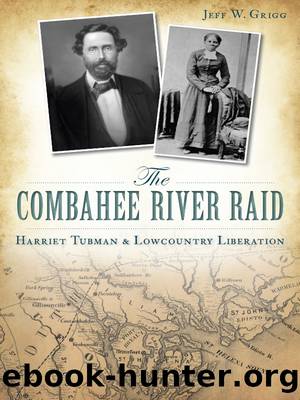The Combahee River Raid by Jeff W. Grigg

Author:Jeff W. Grigg [Grigg, Jeff W.]
Language: eng
Format: epub
Tags: History, African American & Black, United States, Civil War Period (1850-1877), State & Local, South (AL; AR; FL; GA; KY; LA; MS; NC; SC; TN; VA; WV)
ISBN: 9781625850041
Google: l4OACQAAQBAJ
Publisher: Arcadia Publishing
Published: 2014-10-28T02:48:31+00:00
The Confederates had ample warning that something was afoot in the Third District. The previous year, it had been reported that a group of twenty-five Union troops exchanged fire with two or three Confederate pickets at one of William Heywardâs plantations on the lower Combahee River. Northern newspapers also gave warning. A month earlier, the New York Tribune had stated, âThe negro troops at Hilton Head, S.C., will soon start upon an expedition, under the commend of Colonel Montgomery, different in many respects from any heretofore projected.â The Confederates had copies of these newspapers and distributed warnings to the commands in the field.167
On May 26, the Confederate pickets received special orders from McPhersonville warning that if there were any more false alarms, they would be court-martialed. The orders further stated that if the enemy did show and they failed to keep in close contact, they would be subject to âthe charge of cowardice and to be tried by court-martial.â This order was in response to a number of false alarms in the Third District. So, while they should have been more alert, at the same time, they were less likely to raise an alarm until absolutely certain of the situation. McPhersonville was the largest camp in the Third District and was about twenty miles south of Green Pond on the Charleston and Savannah Railroad.168
On May 27, a circular was issued to the planters in the Third District and posted at railroad stations. It read: âIt is the wish of the commanding general that you advise all planters and owners of negroes in your military district to remove their negroes as far as practicable into the interior of the State, as otherwise they are liable to be lost at any moment.â Yet few planters in the district paid much attention; it was, after all, the height of the rice-growing season, and all hands were needed in the fields. If they removed their slaves, there would be no crop that year, which would be economically disastrous.169
The three army transportsâthe John Adams, a converted ferryboat of the East Boston Line; the Harriet A. Weed, a steam tug and troop transport; and the Sentinelâlay quietly at the wharf in Beaufort. Both the John Adams and the Harriet A. Weed were armed. The John Adams was the most heavily armed, with both a ten- and a twenty-pounder Parrott gun and two howitzers, while the Harriet A. Weed carried two cannon.170
The guns on these boats were manned by the Third Rhode Island Heavy Artillery, Company C, under Captain Charles R. Brayton. The Third Rhode Island manned the guns on most of the inland gunboats assigned to the army, of which virtually all were converted from civilian use. The John Adams, being a converted double side-wheel steamer, was uniquely suited for patrolling and transporting on the shallow rivers and bays of the Department of the South. Its large carrying capacity, maneuverability and stable platform allowed it to carry the troops and guns easily.
Download
This site does not store any files on its server. We only index and link to content provided by other sites. Please contact the content providers to delete copyright contents if any and email us, we'll remove relevant links or contents immediately.
| General | Discrimination & Racism |
Nudge - Improving Decisions about Health, Wealth, and Happiness by Thaler Sunstein(7204)
iGen by Jean M. Twenge(5131)
The Fire Next Time by James Baldwin(4994)
Adulting by Kelly Williams Brown(4202)
The Hacking of the American Mind by Robert H. Lustig(4057)
The Sports Rules Book by Human Kinetics(4050)
The Ethical Slut by Janet W. Hardy(4013)
Captivate by Vanessa Van Edwards(3700)
Mummy Knew by Lisa James(3502)
In a Sunburned Country by Bill Bryson(3338)
The Worm at the Core by Sheldon Solomon(3301)
Ants Among Elephants by Sujatha Gidla(3266)
Suicide: A Study in Sociology by Emile Durkheim(2886)
The Slow Fix: Solve Problems, Work Smarter, and Live Better In a World Addicted to Speed by Carl Honore(2823)
The 48 laws of power by Robert Greene & Joost Elffers(2748)
Humans of New York by Brandon Stanton(2663)
Handbook of Forensic Sociology and Psychology by Stephen J. Morewitz & Mark L. Goldstein(2592)
The Happy Hooker by Xaviera Hollander(2564)
The Tipping Point by Malcolm Gladwell(2530)
